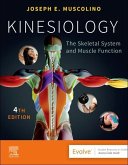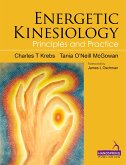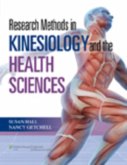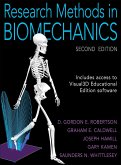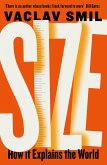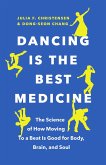- Broschiertes Buch
- Merkliste
- Auf die Merkliste
- Bewerten Bewerten
- Teilen
- Produkt teilen
- Produkterinnerung
- Produkterinnerung
Statistics in Kinesiology, Fifth Edition, introduces basic statistical concepts, with an emphasis on those commonly used in the exercise sciences. Examples drawn from kinesiology fields and extensive problem sets facilitate a deeper understanding of statistical methods and their applications.
Andere Kunden interessierten sich auch für
![Kinesiology Kinesiology]() Joseph E. Muscolino (Instructor, Purchase College, State UniversityKinesiology84,99 €
Joseph E. Muscolino (Instructor, Purchase College, State UniversityKinesiology84,99 €![Energetic Kinesiology Energetic Kinesiology]() Charles KrebsEnergetic Kinesiology73,99 €
Charles KrebsEnergetic Kinesiology73,99 €![Research Methods in Kinesiology and the Health Sciences Research Methods in Kinesiology and the Health Sciences]() Susan HallResearch Methods in Kinesiology and the Health Sciences109,99 €
Susan HallResearch Methods in Kinesiology and the Health Sciences109,99 €![Research Methods in Biomechanics Research Methods in Biomechanics]() D. Gordon E. RobertsonResearch Methods in Biomechanics117,99 €
D. Gordon E. RobertsonResearch Methods in Biomechanics117,99 €![Yogabody: Anatomy, Kinesiology, and Asana Yogabody: Anatomy, Kinesiology, and Asana]() Judith Hanson LasaterYogabody: Anatomy, Kinesiology, and Asana30,99 €
Judith Hanson LasaterYogabody: Anatomy, Kinesiology, and Asana30,99 €![Size Size]() Vaclav SmilSize22,99 €
Vaclav SmilSize22,99 €![Dancing Is the Best Medicine Dancing Is the Best Medicine]() Julia F. ChristensenDancing Is the Best Medicine17,99 €
Julia F. ChristensenDancing Is the Best Medicine17,99 €-
-
-
Statistics in Kinesiology, Fifth Edition, introduces basic statistical concepts, with an emphasis on those commonly used in the exercise sciences. Examples drawn from kinesiology fields and extensive problem sets facilitate a deeper understanding of statistical methods and their applications.
Hinweis: Dieser Artikel kann nur an eine deutsche Lieferadresse ausgeliefert werden.
Hinweis: Dieser Artikel kann nur an eine deutsche Lieferadresse ausgeliefert werden.
Produktdetails
- Produktdetails
- Verlag: Human Kinetics Publishers
- Fifth Edition
- Seitenzahl: 312
- Erscheinungstermin: 16. März 2020
- Englisch
- Abmessung: 218mm x 284mm x 23mm
- Gewicht: 882g
- ISBN-13: 9781492560715
- ISBN-10: 1492560715
- Artikelnr.: 59369415
- Herstellerkennzeichnung
- Libri GmbH
- Europaallee 1
- 36244 Bad Hersfeld
- gpsr@libri.de
- Verlag: Human Kinetics Publishers
- Fifth Edition
- Seitenzahl: 312
- Erscheinungstermin: 16. März 2020
- Englisch
- Abmessung: 218mm x 284mm x 23mm
- Gewicht: 882g
- ISBN-13: 9781492560715
- ISBN-10: 1492560715
- Artikelnr.: 59369415
- Herstellerkennzeichnung
- Libri GmbH
- Europaallee 1
- 36244 Bad Hersfeld
- gpsr@libri.de
Joseph P. Weir, PhD, is the chair of the department of health, sport, and exercise sciences at the University of Kansas. From 1995 to 2012 he was a professor in the physical therapy doctorate program at Des Moines University in Iowa. He earned his doctorate in exercise physiology from the University of Nebraska at Lincoln. Weir is a fellow of both the American College of Sports Medicine (ACSM) and the National Strength and Conditioning Association (NSCA). He was given the NSCA President’s Award in 2007 and its William J. Kraemer Outstanding Sport Scientist Award in 2006. He served as president of the National Strength and Conditioning Association Foundation from 2006 to 2009, and he was cochair of the ACSM’s Biostatistics Interest Group from 2001 to 2003. Weir is a senior associate editor of the Journal of Strength and Conditioning Research, and he is a member of the editorial board of Medicine and Science in Sports and Exercise. He is the author of numerous research articles, which have appeared in European Journal of Applied Physiology, Physiological Measurement, American Journal of Physiology, and Journal of Orthopaedic and Sports Physical Therapy. He is coauthor of Physical Fitness Laboratories on a Budget, and he has contributed chapters to seven texts, including NSCA’s Essentials of Personal Training. Weir is originally from Glennallen, Alaska. He and his wife, Loree, live in Lawrence, Kansas, and have three adult children. He is an avid motorcyclist and a fan of University of Nebraska football, University of Kansas basketball, and Boston Bruins hockey. William J. Vincent, EdD, is a retired adjunct professor and former director of the general education wellness program in the department of exercise sciences at Brigham Young University in Provo, Utah. He is a professor emeritus and the former chair of the department of kinesiology at California State University at Northridge (CSUN). He was employed at CSUN for 40 years and taught statistics and measurement theory for 35 of those years. In 1995 he received the university’s Distinguished Teaching Award. Vincent has been a member of the American Alliance for Health, Physical Education, Recreation and Dance (AAHPERD), now SHAPE America, since 1964. In 2007, he received the AAHPERD National Honor Award for distinguished service to the profession. He has served as the president of the Southwest District of AAHPERD and was a member of the AAHPERD board of governors from 1993 to 1995. In 1988 he was named the Southwest District Scholar and delivered the keynote address, titled "From Means to MANOVA," at the 1989 convention. Vincent is the author or coauthor of four books and more than 70 professional articles. Fifty-one of those articles appeared in refereed journals, including Research Quarterly for Exercise and Sport, International Journal of Sports Medicine, and Journal of Athletic Training . He has a bachelor’s degree in physical education (pedagogy), a master’s degree in physical education (exercise physiology), and a doctorate in educational psychology (perception and learning), all from the University of California at Los Angeles. Vincent lives in Lindon, Utah. He and his late wife, Diana, raised six children, and he has 24 grandchildren and nine great-grandchildren. In his free time, he enjoys camping, snow skiing and water skiing, conducting genealogical research, and reading.
Chapter 1. Measurement, Statistics, and Research
What Is Measurement?
Process of Measurement
Variables and Constants
Research Design and Statistical Analysis
Statistical Inference
Summary
Chapter 2. Organizing and Displaying Data
Organizing Data
Displaying Data
Summary
Chapter 3. Percentiles
Common Percentile Divisions
Calculations Using Percentiles
Summary
Chapter 4. Measures of Central Tendency
Mode
Median
Mean
Relationships Among the Mode, Median, and Mean
Summary
Chapter 5. Measures of Variability
Range
Interquartile Range
Variance
Standard Deviation
Definition Method of Hand Calculations
Calculating Standard Deviation for a Sample
Coefficient of Variation
Standard Deviation and Normal Distribution
Summary
Chapter 6. The Normal Curve
Z Scores
Standard Scores
Probability and Odds
Calculating Skewness and Kurtosis
Summary
Chapter 7. Fundamentals of Statistical Inference
Predicting Population Parameters Using Statistical Inference
Estimating Sampling Error
Levels of Confidence, Confidence Intervals, and Probability of Error
An Example Using Statistical Inference
Statistical Hypothesis Testing
Type I and Type II Error
Degrees of Freedom
Living With Uncertainty
Two- and One-Tailed Tests
Applying Confidence Intervals
Summary
Chapter 8. Correlation and Bivariate Regression
Correlation
Calculating the Correlation Coefficient
Bivariate Regression
Homoscedasticity
Summary
Chapter 9. Multiple Correlation and Multiple Regression
Multiple Correlation
Partial Correlation
Multiple Regression
Summary
Chapter 10. The t Test: Comparing Means From Two Sets of Data
The t Tests
Types of t Tests
Magnitude of the Difference (Size of Effect)
Determining Power and Sample Size
The t Test for Proportions
Summary
Chapter 11. Simple Analysis of Variance: Comparing the Means Among Three or
More Sets of Data
Assumptions in ANOVA
Sources of Variance
Calculating F: The Definition Method
Determining the Significance of F
Post Hoc Tests
Magnitude of the Treatment (Size of Effect)
Summary
Chapter 12. Analysis of Variance With Repeated Measures
Assumptions in Repeated Measures ANOVA
Calculating Repeated Measures ANOVA
Correcting for Violations of the Assumption of Sphericity
Post Hoc Tests
Interpreting the Results
An Example From Leisure Studies and Recreation
Summary
Chapter 13. Quantifying Reliability
Intraclass Correlation Coefficient
Standard Error of Measurement
Summary
Chapter 14. Factorial Analysis of Variance
A Between–Between Example
A Between–Within Example
A Within–Within Example
Summary
Chapter 15. Analysis of Covariance
Relationship Between ANOVA and Regression
ANCOVA and Statistical Power
Assumptions in ANCOVA
The Pretest–Posttest Control Group Design
Pairwise Comparisons
Summary
Chapter 16. Analysis of Nonparametric Data
Chi-Square (Single Classification)
Chi-Square (Two or More Classifications)
Rank Order Correlation
Mann-Whitney U Test
Kruskal-Wallis ANOVA for Ranked Data
Friedman’s Two-Way ANOVA by Ranks
Summary
Chapter 17. Clinical Measures of Association
Relative Risk
Odds Ratio
Diagnostic Testing
Summary
Chapter 18. Advanced Statistical Procedures
Multilevel Modeling
Meta-Analysis
Multiple Analysis of Variance
Factor Analysis
Discriminant Analysis
Summary
Appendix: Statistical Tables
What Is Measurement?
Process of Measurement
Variables and Constants
Research Design and Statistical Analysis
Statistical Inference
Summary
Chapter 2. Organizing and Displaying Data
Organizing Data
Displaying Data
Summary
Chapter 3. Percentiles
Common Percentile Divisions
Calculations Using Percentiles
Summary
Chapter 4. Measures of Central Tendency
Mode
Median
Mean
Relationships Among the Mode, Median, and Mean
Summary
Chapter 5. Measures of Variability
Range
Interquartile Range
Variance
Standard Deviation
Definition Method of Hand Calculations
Calculating Standard Deviation for a Sample
Coefficient of Variation
Standard Deviation and Normal Distribution
Summary
Chapter 6. The Normal Curve
Z Scores
Standard Scores
Probability and Odds
Calculating Skewness and Kurtosis
Summary
Chapter 7. Fundamentals of Statistical Inference
Predicting Population Parameters Using Statistical Inference
Estimating Sampling Error
Levels of Confidence, Confidence Intervals, and Probability of Error
An Example Using Statistical Inference
Statistical Hypothesis Testing
Type I and Type II Error
Degrees of Freedom
Living With Uncertainty
Two- and One-Tailed Tests
Applying Confidence Intervals
Summary
Chapter 8. Correlation and Bivariate Regression
Correlation
Calculating the Correlation Coefficient
Bivariate Regression
Homoscedasticity
Summary
Chapter 9. Multiple Correlation and Multiple Regression
Multiple Correlation
Partial Correlation
Multiple Regression
Summary
Chapter 10. The t Test: Comparing Means From Two Sets of Data
The t Tests
Types of t Tests
Magnitude of the Difference (Size of Effect)
Determining Power and Sample Size
The t Test for Proportions
Summary
Chapter 11. Simple Analysis of Variance: Comparing the Means Among Three or
More Sets of Data
Assumptions in ANOVA
Sources of Variance
Calculating F: The Definition Method
Determining the Significance of F
Post Hoc Tests
Magnitude of the Treatment (Size of Effect)
Summary
Chapter 12. Analysis of Variance With Repeated Measures
Assumptions in Repeated Measures ANOVA
Calculating Repeated Measures ANOVA
Correcting for Violations of the Assumption of Sphericity
Post Hoc Tests
Interpreting the Results
An Example From Leisure Studies and Recreation
Summary
Chapter 13. Quantifying Reliability
Intraclass Correlation Coefficient
Standard Error of Measurement
Summary
Chapter 14. Factorial Analysis of Variance
A Between–Between Example
A Between–Within Example
A Within–Within Example
Summary
Chapter 15. Analysis of Covariance
Relationship Between ANOVA and Regression
ANCOVA and Statistical Power
Assumptions in ANCOVA
The Pretest–Posttest Control Group Design
Pairwise Comparisons
Summary
Chapter 16. Analysis of Nonparametric Data
Chi-Square (Single Classification)
Chi-Square (Two or More Classifications)
Rank Order Correlation
Mann-Whitney U Test
Kruskal-Wallis ANOVA for Ranked Data
Friedman’s Two-Way ANOVA by Ranks
Summary
Chapter 17. Clinical Measures of Association
Relative Risk
Odds Ratio
Diagnostic Testing
Summary
Chapter 18. Advanced Statistical Procedures
Multilevel Modeling
Meta-Analysis
Multiple Analysis of Variance
Factor Analysis
Discriminant Analysis
Summary
Appendix: Statistical Tables
Chapter 1. Measurement, Statistics, and Research
What Is Measurement?
Process of Measurement
Variables and Constants
Research Design and Statistical Analysis
Statistical Inference
Summary
Chapter 2. Organizing and Displaying Data
Organizing Data
Displaying Data
Summary
Chapter 3. Percentiles
Common Percentile Divisions
Calculations Using Percentiles
Summary
Chapter 4. Measures of Central Tendency
Mode
Median
Mean
Relationships Among the Mode, Median, and Mean
Summary
Chapter 5. Measures of Variability
Range
Interquartile Range
Variance
Standard Deviation
Definition Method of Hand Calculations
Calculating Standard Deviation for a Sample
Coefficient of Variation
Standard Deviation and Normal Distribution
Summary
Chapter 6. The Normal Curve
Z Scores
Standard Scores
Probability and Odds
Calculating Skewness and Kurtosis
Summary
Chapter 7. Fundamentals of Statistical Inference
Predicting Population Parameters Using Statistical Inference
Estimating Sampling Error
Levels of Confidence, Confidence Intervals, and Probability of Error
An Example Using Statistical Inference
Statistical Hypothesis Testing
Type I and Type II Error
Degrees of Freedom
Living With Uncertainty
Two- and One-Tailed Tests
Applying Confidence Intervals
Summary
Chapter 8. Correlation and Bivariate Regression
Correlation
Calculating the Correlation Coefficient
Bivariate Regression
Homoscedasticity
Summary
Chapter 9. Multiple Correlation and Multiple Regression
Multiple Correlation
Partial Correlation
Multiple Regression
Summary
Chapter 10. The t Test: Comparing Means From Two Sets of Data
The t Tests
Types of t Tests
Magnitude of the Difference (Size of Effect)
Determining Power and Sample Size
The t Test for Proportions
Summary
Chapter 11. Simple Analysis of Variance: Comparing the Means Among Three or
More Sets of Data
Assumptions in ANOVA
Sources of Variance
Calculating F: The Definition Method
Determining the Significance of F
Post Hoc Tests
Magnitude of the Treatment (Size of Effect)
Summary
Chapter 12. Analysis of Variance With Repeated Measures
Assumptions in Repeated Measures ANOVA
Calculating Repeated Measures ANOVA
Correcting for Violations of the Assumption of Sphericity
Post Hoc Tests
Interpreting the Results
An Example From Leisure Studies and Recreation
Summary
Chapter 13. Quantifying Reliability
Intraclass Correlation Coefficient
Standard Error of Measurement
Summary
Chapter 14. Factorial Analysis of Variance
A Between–Between Example
A Between–Within Example
A Within–Within Example
Summary
Chapter 15. Analysis of Covariance
Relationship Between ANOVA and Regression
ANCOVA and Statistical Power
Assumptions in ANCOVA
The Pretest–Posttest Control Group Design
Pairwise Comparisons
Summary
Chapter 16. Analysis of Nonparametric Data
Chi-Square (Single Classification)
Chi-Square (Two or More Classifications)
Rank Order Correlation
Mann-Whitney U Test
Kruskal-Wallis ANOVA for Ranked Data
Friedman’s Two-Way ANOVA by Ranks
Summary
Chapter 17. Clinical Measures of Association
Relative Risk
Odds Ratio
Diagnostic Testing
Summary
Chapter 18. Advanced Statistical Procedures
Multilevel Modeling
Meta-Analysis
Multiple Analysis of Variance
Factor Analysis
Discriminant Analysis
Summary
Appendix: Statistical Tables
What Is Measurement?
Process of Measurement
Variables and Constants
Research Design and Statistical Analysis
Statistical Inference
Summary
Chapter 2. Organizing and Displaying Data
Organizing Data
Displaying Data
Summary
Chapter 3. Percentiles
Common Percentile Divisions
Calculations Using Percentiles
Summary
Chapter 4. Measures of Central Tendency
Mode
Median
Mean
Relationships Among the Mode, Median, and Mean
Summary
Chapter 5. Measures of Variability
Range
Interquartile Range
Variance
Standard Deviation
Definition Method of Hand Calculations
Calculating Standard Deviation for a Sample
Coefficient of Variation
Standard Deviation and Normal Distribution
Summary
Chapter 6. The Normal Curve
Z Scores
Standard Scores
Probability and Odds
Calculating Skewness and Kurtosis
Summary
Chapter 7. Fundamentals of Statistical Inference
Predicting Population Parameters Using Statistical Inference
Estimating Sampling Error
Levels of Confidence, Confidence Intervals, and Probability of Error
An Example Using Statistical Inference
Statistical Hypothesis Testing
Type I and Type II Error
Degrees of Freedom
Living With Uncertainty
Two- and One-Tailed Tests
Applying Confidence Intervals
Summary
Chapter 8. Correlation and Bivariate Regression
Correlation
Calculating the Correlation Coefficient
Bivariate Regression
Homoscedasticity
Summary
Chapter 9. Multiple Correlation and Multiple Regression
Multiple Correlation
Partial Correlation
Multiple Regression
Summary
Chapter 10. The t Test: Comparing Means From Two Sets of Data
The t Tests
Types of t Tests
Magnitude of the Difference (Size of Effect)
Determining Power and Sample Size
The t Test for Proportions
Summary
Chapter 11. Simple Analysis of Variance: Comparing the Means Among Three or
More Sets of Data
Assumptions in ANOVA
Sources of Variance
Calculating F: The Definition Method
Determining the Significance of F
Post Hoc Tests
Magnitude of the Treatment (Size of Effect)
Summary
Chapter 12. Analysis of Variance With Repeated Measures
Assumptions in Repeated Measures ANOVA
Calculating Repeated Measures ANOVA
Correcting for Violations of the Assumption of Sphericity
Post Hoc Tests
Interpreting the Results
An Example From Leisure Studies and Recreation
Summary
Chapter 13. Quantifying Reliability
Intraclass Correlation Coefficient
Standard Error of Measurement
Summary
Chapter 14. Factorial Analysis of Variance
A Between–Between Example
A Between–Within Example
A Within–Within Example
Summary
Chapter 15. Analysis of Covariance
Relationship Between ANOVA and Regression
ANCOVA and Statistical Power
Assumptions in ANCOVA
The Pretest–Posttest Control Group Design
Pairwise Comparisons
Summary
Chapter 16. Analysis of Nonparametric Data
Chi-Square (Single Classification)
Chi-Square (Two or More Classifications)
Rank Order Correlation
Mann-Whitney U Test
Kruskal-Wallis ANOVA for Ranked Data
Friedman’s Two-Way ANOVA by Ranks
Summary
Chapter 17. Clinical Measures of Association
Relative Risk
Odds Ratio
Diagnostic Testing
Summary
Chapter 18. Advanced Statistical Procedures
Multilevel Modeling
Meta-Analysis
Multiple Analysis of Variance
Factor Analysis
Discriminant Analysis
Summary
Appendix: Statistical Tables


